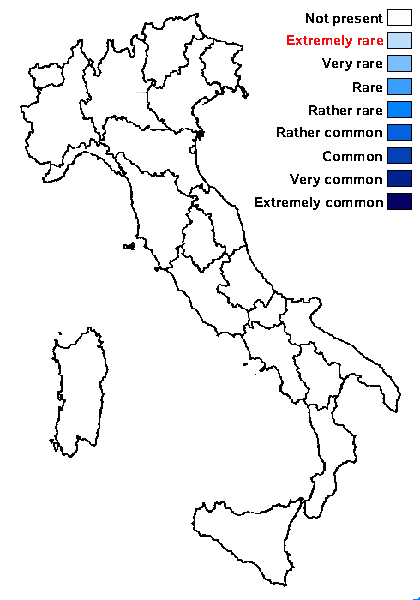Thelidium fumidum (Nyl.) Hazsl.
Magyar Birodalom Zuzmó-Flórájá: 263, 1884.. Basionym: Verrucaria fumida Nyl. - Flora (Regensburg), 57: 317, 1874.
Synonyms:
Distribution:
Description: Thallus crustose, episubstratic, 0.1-0.2 mm thick, brown-black, matt, continuous or partly finely rimose, with a brown-black medullary layer. Perithecia numerous, black, globose, immersed in 0.3-0.6 mm wide thalline warts, projecting only with the ostiolar region. Involucrellum spreading, reaching down to the base of the perithecium and there continuous with the black basal layer, the pigment dark reddish brown, K + dark grey-brown; exciple 0.18-0.36 mm across; hamathecium of periphyses and periphysoids, interascal filaments absent; hymenial gel I+ red (I+ blue at very low concentrations of I), K/I+ blue. Asci 8-spored, ellipsoid to clavate, I-, fissitunicate, the wall thickened above, with an ocular chamber, dehiscent by extrusion of a delicate rostrum. Ascospores 1-septate, hyaline, ellipsoid, (24-)25-30(-34) x (9-)10-13(-15) μm. Photobiont chlorococcoid. Spot tests: K-, C-, KC-, P-, UV-. Chemistry: without lichen substances.
Note: a calcicolous species, rare throughout Eastern and Central Europe, with a few scattered records from the Alps outside Italy; to be looked for in the Italian Alps.
Growth form: Crustose
Substrata: rocks
Photobiont: green algae other than Trentepohlia
Reproductive strategy: mainly sexual

Predictive model
Growth form: Crustose
Substrata: rocks
Photobiont: green algae other than Trentepohlia
Reproductive strategy: mainly sexual

Predictive model
 Index Fungorum
Index Fungorum
 GBIF
GBIF

